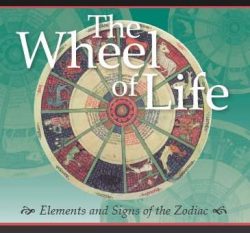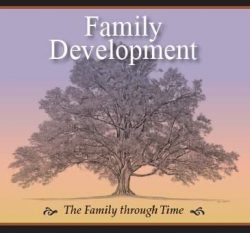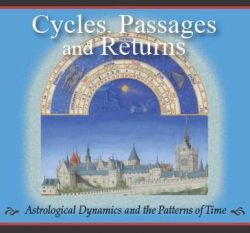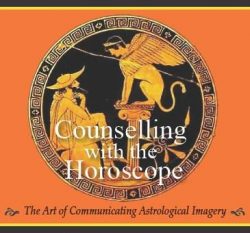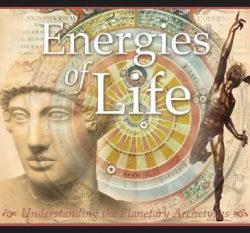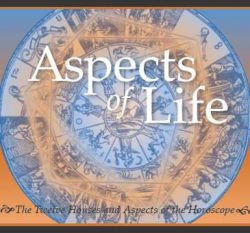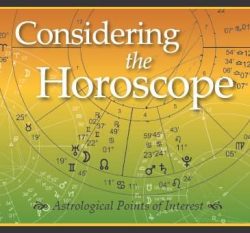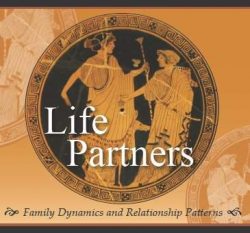-
Elements and Signs of the Zodiac
After an introduction to the imaginative and enduring study of astrology, we begin our journey with investigating the heavenly wheel of life or the zodiac. The Greek root of the word refers to a circle of sculptured animals or life-like figures. Therefore the zodiac means a circle of animals, a wheel of life and in essence is one of the first picture books. We will study these zodiacal images through the traditional astrological divisions of the four elements and the three qualities, along their psychological and astrological correspondences. The elements and qualities of the zodiac reveal subtleties of human temperament, character and personality. Considering the zodiac includes its history and astronomy to understand its development and how constellations are different from zodiac signs. Each sign will be covered in detail examining their astrological descriptions, as well as the mythic template that underpins their images. The signs of the zodiac also symbolise twelve initiatory stages in the individuation process; therefore the study of each sign is not only an insight into human temperament, but also reveal essential qualities of human experience. One USB stick containing 11 units plus workbooks and booklets -
The Family Through Time
Ancestral patterns are inborn; therefore these images will also be embedded in our horoscopes and this unit concentrates on the transmission of these patterns through the family over time examining various areas of the familial experience. Using astrological and psychological theory we will explore the family life cycle, family and ancestral patterns carried through the generations. Areas to be covered include the family of origin, working with a genogram, family myths and patterns, early stages of childhood, adolescence, leaving home, marriage and the extended family, mid life and beyond as well as specific topics such as family secrets, birth order, family dysfunction etc. This course helps draw the family portrait using astrological images and track the familial inheritance through horoscopes of family members. This module includes 8 CDs, one workbook, one reading booklet and the booklet Family Development: The Family System through Time. One USB stick containing 8 units plus workbooks and booklets -
Astrological Dynamics and the Patterns of Time
The nature of astrological time is cyclical. Embedded in each planetary cycle is the ancient notion of the eternal return and recurrence. This course addresses the nature of time in its linear and cyclical temperament as well as the nature of astrological timing and prediction. When astrological time is applied to the human experience life cycle passages and natural initiatory periods in the life cycle are evident. In this module we will review the planetary cycles in depth and focus on the passages of the life cycle and the initiations that occur at important stages. The principle of return will be amplified and the technique of return charts will be introduced, especially the solar return chart and its cycles. Studying the solar return horoscopes over the course of a lifetime will be examined. We will appraise astrological methods for delineating specific periods of time, which will deepen our perspective on transits and progressions with alternate viewpoints and techniques. This module includes 8 CDs, one workbook, one reading booklet and two booklets: Dynamic Solar Returns and Planetary Pairs: Symmetry of the Spheres. One USB stick containing 9 units plus workbooks and booklets -
The Art of Communicating Astrological Imagery
Our first look at a horoscope presents us with an abundance of symbols, images, ideas, intuitions, feelings, opinions and narratives. How do we begin to understand these impressions and find a way to communicate them to the holder of the horoscope? How do we find words for a symbolic language? This module will contemplate astrology from a counselling perspective, reviewing counselling skills and techniques, ethics and how to effectively communicate with a client about their horoscope. We will bring our attention to the use of symbolism, imagery, metaphors and myths and reflect on the spectrum from literal to imaginative thinking. Case studies will be used to illustrate different issues that arise in the consulting process. This module includes 8 CDs, one workbook, one reading booklet and the booklet Myth, Metaphor, Dream and Symbol: The Imaginative Language of Astrology. One USB stick containing 8 units plus workbooks and booklets -
Planetary Archetypes
The contemporary planetary pantheon consists of the traditional seven planets which include the two luminaries of the Sun and Moon. The other five planets known to the ancients of Mesopotamia and Greece were Mercury, Venus, Mars, Jupiter and Saturn. However, towards the end of the 18th Century CE, another planet was discovered and named Uranus which changed the composition of the known solar system. And since then Neptune and Pluto along with a host of other minor and ‘dwarf’ planets have been discovered, including Chiron. It is these planets which we will study in detail and depth. Planets are potent metaphors of our personal, social and collective experiences. Metaphorically planets symbolise the powerful urges, impulses, energies and instincts that underpin all of life, which motivate and influence every human being. Therefore each planetary archetype will be thoroughly examined with reference to their psychological and astrological qualities. As archetypes of human experience, planets were once conceived as divine; hence each has their unique mythology which we will study. -
Planetary Archetypes
The contemporary planetary pantheon consists of the traditional seven planets which include the two luminaries of the Sun and Moon. The other five planets known to the ancients of Mesopotamia and Greece were Mercury, Venus, Mars, Jupiter and Saturn. However, towards the end of the 18th Century CE, another planet was discovered and named Uranus which changed the composition of the known solar system. And since then Neptune and Pluto along with a host of other minor and ‘dwarf’ planets have been discovered, including Chiron. It is these planets which we will study in detail and depth. Planets are potent metaphors of our personal, social and collective experiences. Metaphorically planets symbolise the powerful urges, impulses, energies and instincts that underpin all of life, which motivate and influence every human being. Therefore each planetary archetype will be thoroughly examined with reference to their psychological and astrological qualities. As archetypes of human experience, planets were once conceived as divine; hence each has their unique mythology which we will study. One USB stick containing 10 units plus workbooks and booklets -
The Twelve Houses and Aspects of the Horoscope
To contemplate and find meaning in the symbols of the sky from a particular place, astrologers use the angles of the horoscope to orientate themselves. Angles take shape when certain great circles intersect with the ecliptic, another imaginary line sketched on the canvas of the heavens by the Sun. The angles of the horoscope or the Ascendant, Descendant, MC, and IC are the reference points of our lives and orientate us to the world. These form the axes of the horoscope which we will study, along with the quadrants and hemispheres. The twelve houses will be introduced in reference to the process of human development and experience. We will begin to synthesise planets in signs and houses to give meaning to astrological statements. Major aspects are the astrological threads connecting planets that weave archetypal patterns into the tapestry of our lives. Aspects are planetary dialogues which reveal sub-personalities in the horoscope. As the lifelines between planets, aspects will be thoroughly examined including major patterns and planetary pictures. Many examples of the complexity of planets in aspect will be examined. -
The Twelve Houses and Aspects of the Horoscope
To contemplate and find meaning in the symbols of the sky from a particular place, astrologers use the angles of the horoscope to orientate themselves. Angles take shape when certain great circles intersect with the ecliptic, another imaginary line sketched on the canvas of the heavens by the Sun. The angles of the horoscope or the Ascendant, Descendant, MC, and IC are the reference points of our lives and orientate us to the world. These form the axes of the horoscope which we will study, along with the quadrants and hemispheres. The twelve houses will be introduced in reference to the process of human development and experience. We will begin to synthesise planets in signs and houses to give meaning to astrological statements. Major aspects are the astrological threads connecting planets that weave archetypal patterns into the tapestry of our lives. Aspects are planetary dialogues which reveal sub-personalities in the horoscope. As the lifelines between planets, aspects will be thoroughly examined including major patterns and planetary pictures. Many examples of the complexity of planets in aspect will be examined. One USB stick containing 10 units plus workbooks and booklets -
Astrological Analysis
Since the four main astrological doctrines of signs, planets, houses and aspects have been covered in depth, we will turn our attention to new material on specialised topics in order to have an appreciation of the richness of the horoscope. These include the study of the lunar nodes, another axis in the horoscope which suggests an intriguing encounter with past patterns and destiny; the phenomenon of intercepted signs, which occur when using unequal house systems; understanding the occurrence and meaning of retrograde planets in the horoscope; the lunation cycle or the phase of the cycle you were born under. We will also study this cycle as a prototype of all astrological cycles. As well we will examine the angle of the vertex-anti/vertex and its unique relational imagery as well as studying some of the minor aspects of contemporary astrology. As part of this unit we will be also cover some technical aspects to understand the astronomical basis behind astrological techniques, introduce the ephemeris and also begin to look at a chart as a whole by contemplating how we might analyse, delineate and consider the horoscope. -
Astrological Analysis
Since the four main astrological doctrines of signs, planets, houses and aspects have been covered in depth, we will turn our attention to new material on specialised topics in order to have an appreciation of the richness of the horoscope. These include the study of the lunar nodes, another axis in the horoscope which suggests an intriguing encounter with past patterns and destiny; the phenomenon of intercepted signs, which occur when using unequal house systems; understanding the occurrence and meaning of retrograde planets in the horoscope; the lunation cycle or the phase of the cycle you were born under. We will also study this cycle as a prototype of all astrological cycles. As well we will examine the angle of the vertex-anti/vertex and its unique relational imagery as well as studying some of the minor aspects of contemporary astrology. As part of this unit we will be also cover some technical aspects to understand the astronomical basis behind astrological techniques, introduce the ephemeris and also begin to look at a chart as a whole by contemplating how we might analyse, delineate and consider the horoscope. One USB stick containing 10 units plus workbooks and booklets -
Family Dynamics & Relationship Patterns
While developmental psychology emphasises the influence of the parents and family on an individual’s maturity, astrological doctrine suggests their imprint is already etched upon the soul at birth. Its perspective suggests that the images of the parents, the familial complexes and inheritances are innate, which suggests that the soul already has an essential template for its experience. Astrology allows us to reflect on familial fate and ways of being authentic with our ancestral inheritance.

